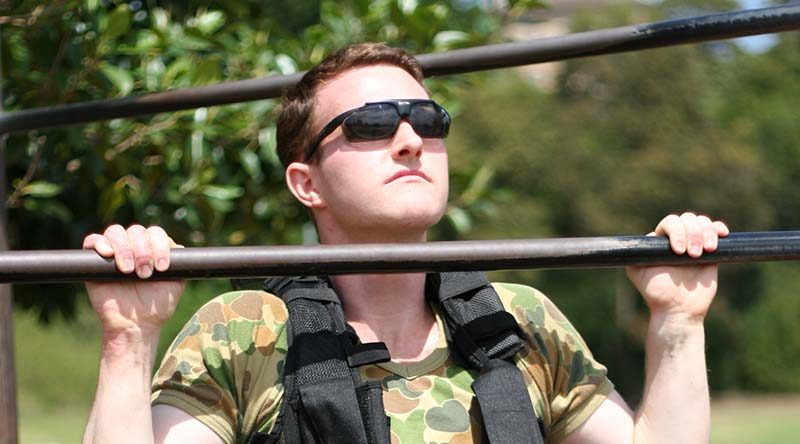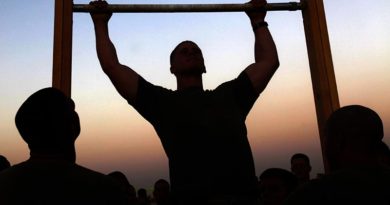Military Fitness – Part 20


Last instalment we looked at a program designed to take virtually anyone from dangling helplessly on the bar to a set of five or more unassisted pull-ups. This time I’ll outline a few advanced pull-up variations and give you a program to boost your numbers to elite levels.
Some numbers to aim for:
> 20 strict pull-ups – maximum points on the US Marine Corp fitness test
> 18 reps wearing a 10kg vest – minimum standard for Russian special forces
 Beat The Beep Test by Don Stevenson is an 89-page complete guide to beep-test training and preparation.
Beat The Beep Test by Don Stevenson is an 89-page complete guide to beep-test training and preparation.
20% of proceeds from the sale of this e-book will be donated to Soldier On
Advanced variations
When training to maximise your pull-up numbers, you’ll mostly use the basic pull-up technique. However, there are a few variations that have proven useful to add to programs.
Weighted pull-ups
Pull-up training is equal parts strength and local muscular endurance.
Once you reach a certain number of reps per set (around 10-12), standard pull-ups stop developing strength effectively and only really develop muscular endurance.
This is a problem because, ultimately, the stronger you are the easier reps become!
To knock the reps down and keep the strength focus, you’ll need to add weight.
The two most common methods of adding weight are to attach a weight to a belt around the waist or to wear a weighted vest.
One other way that is very useful is to hang one or two light kettlebells from the feet.
This has the advantage of allowing the weights to be dropped during the set (see extended sets below).
Towel pull-ups
Grab a strong towel (don’t use anything too old, they tend to rip and drop you on your butt) and chuck it over the bar.
Grab one side in each hand and pull.
Towel pull-ups work the grip, are easy on the shoulders and make for a good variation on regular pull-ups.
Asymmetric pull-ups
You can either do these by taking a moderately wide overhand grip of the bar and then pulling the chin to alternate hands, or another option is to set up a pair of rings at slightly different heights.
Whichever option you choose, the goal is to place a higher percentage of the load on one side at a time.
Eventually this tactic can even be used by lighter individuals to work up to one-arm pull-ups!
Jumping negatives
Stand under the bar and jump into the top position before lowering under control.
Be very careful not to do high volumes of these as they may leave you very sore.
Extended sets
In an extended set, the aim is to start with one variation of the pull-up and then switch to an easier version once you can no longer perform reps of the initial variation.
Examples would include doing weighted pull-ups with a kettlebell on the feet and then finishing with regular pull-ups by dropping the kettle bell – or starting with regular pull-ups and switching to jumping negatives.
In extended sets the number of ‘extra’ reps should be less than the number of reps of the initial exercise.
Extended sets should only be used once a week at most as they will represent a significant overload on the body.
Pull-up program
This program assumes that you can do at least three sets of five strict pull-ups.
Train on three non-consecutive days a week and make pull-ups your first exercise after your warm up.
Day 1 – weighted pull-ups – five sets of max reps with 5kg. Each week add 2.5 to 5kg.
Day 2 – choose either towel or asymmetric pull-ups and do three sets stopping just short of failure. Finish with three sets of regular pull-ups at 70-80% of your rep max. Each week try to add one to two reps to all sets.
Day 3 – choose one variation of extended sets and perform three to six extended sets. Terminate your pull-up training when the number of reps in a set drops below half of your first set.
Continue this program for four weeks with increasing reps and weight, then take a couple of days off upper-body work and retest your maximum reps and your 1RM for weighted pull-ups.
Chances are, after a month, you’ll be closer to 20 reps than you had anticipated.
What’s that guy doing flailing around on the bar?
In recent years, the spread of CrossFit training has introduced the concept of the ‘kipping’ pull-up to the fitness world.
The kipping pull-up uses a swinging or flicking motion to translate horizontal momentum to vertical momentum.
To many pull-up purists, kipping is cheating and, in most cases, they won’t be counted in fitness tests.
CrossFit trainees typically use kipping to increase the number of reps performed in a workout and to increase the speed with which they are performed.
In the past, I’ve done a lot of kipping work and, while I think it’s got a certain utility, you do have to be very careful of a few things.
The first is that kipping can be rough on the shoulders, particularly if you have poor flexibility.
The high forces at the bottom of the movement may also be responsible for injuries in some people.
Secondly, high-rep kipping pull-ups are a major cause of torn calluses.
Some people seem to take this as a badge of honour, but to me, torn calluses are just a painful infection risk and also a pain in the butt to train around!
.
.
.
.
.

.
.

.






